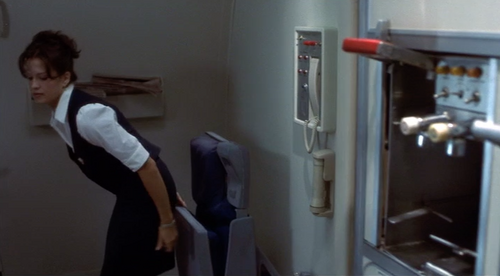Investigation[]
The Seating Chart[]

Alex's original assigned seat, 25 I.
In the original Final Destination, the students from Mt. Abraham High School are seated just at the middle section of the plane where the wings are located. When the students board the plane and begin to make their way to their seats, there is a shot that shows a close-up of the row numbers as Alex Browning makes his way down the aisle toward his assigned seat, Row 25 Seat I.

The seating chart of a Boeing 747 showing where the students actually sat compared to where Sam and Molly also sat on the plane.
It should be noted that the section where the students sat, according to the seating chart of a Boeing 747, is located where the wings are—in the middle of the plane.
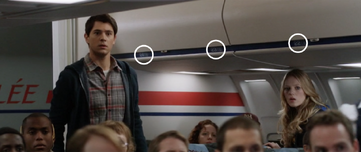
A screenshot from Final Destination 5 showing Sam and Molly's assigned seating at Row 23.
However, in Final Destination 5, it is shown that the students were located at the back of the plane, where Sam Lawton and Molly Harper were also seated. Where this misconception originated from is unknown, but looking closer reveals that Sam and Molly were seated in Row 23 Seats B and A.
In Final Destination 5, as the plane accident occurs, multiple exterior shots show that the fuselage that had torn away (from Engine #1 exploding) was further back of the plane than the section that the students were actually sitting in; the hole that forms where Sam and Molly are sitting is at the very back of the plane, different from where they are actually supposed to be sitting.
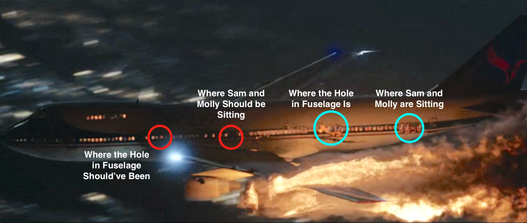
An exterior shot of Flight 180 from Final Destination 5, showing the discrepancies between where the fuselage peels away and where Sam and Molly are seated, compared to where the fuselage should have peeled away and where Sam and Molly should be seated.
The Premonition Explosion vs. The Real-Life Explosion[]
In Final Destination, the plane seems to explode only seconds after takeoff, completely disregarding how long it took for the explosion to occur in the premonition. According to the video below, the side-by-side comparison between the plane exploding in the premonition versus real-life shows that the plane explodes at about the same time. A closer inspection reveals that the reasoning behind this is due to the different circumstances that occur in both the premonition and in real-life.
At the beginning, both scenes start out completely the same, down to the similarity of the timing when Billy Hitchcock tells the flight attendant, “My seat is over there."
However, there is a break in between when the students are thrown off the plane, and when Alex begins to recount his premonition. During this break, Tod Waggner calls Alex’s parents to come and pick him up from the airport, and then grabs a wet rag from the café barista to put on the back of Alex’s neck, allowing about 30 seconds to a minute to pass in real-time compared to in the premonition.
According to the news report on the possible cause behind the explosion of Flight 180:
- “Officials believe deterioration of silicon insulation on an electrical connector to the scavenger pump may have leaked combustible fluids. A spark in the fuel switch in the fuselage may have ignited the fuel line and proceeded to the fuel pump which would have set off the catastrophic explosion.”
In the premonition, as the plane takes off and increases in altitude, the deterioration of the silicon insulation is currently occurring. After enough time has passed while they are in the air, the plane malfunctions due to this deterioration and ultimately causes the explosion.
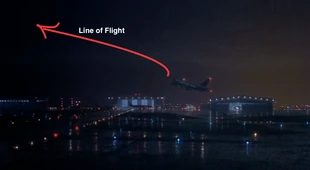
The path of Flight 180 as it departs from the runway.
In comparison, during real-time, the plane remains at the gate during the entire duration of when Alex is kicked off the plane and until he is calmed down while waiting in the terminal. The plane does not pull away from the gate until after Alex has calmed down and begins recounting his vision. Whereas in the vision, since everything occurs per usual, the plane has already taken off at the same instant that Alex have been kicked off the plane in real-time.
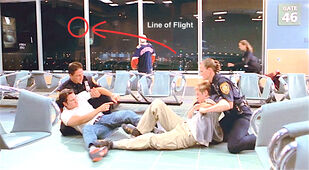
The path of Flight 180 the moment it explodes.
One possible theory is that in real-time, between the moment Alex wakes up from his premonition, and when the plane finally leaves the gate, the silicon insulation was deteriorating during the time that the plane remained on the ground as Alex was being escorted off. Once the plane finally took off, much of the insulation had already been corroded, causing the plane to explode just after takeoff, and much sooner/closer to the airport than in the premonition.
Based on this conspiracy theory, this means that:
- The fuselage does not peel away and suck out the three students
- None of the plane engines catch on fire
- The plane never nosedives before exploding
- There may have never even been a moment where the oxygen masks even dropped from their compartments
- At most, the plane probably shook dramatically before it exploded given the amount of time it was in the air after takeoff (in real-time)
In the edit, the explosions in both real-time and the premonition were purposefully matched up. This allowed up to about a minute of blank space in the real-time scene, which is where, if it were included in the film, we would see Tod calling Alex’s parents and asking the café barista for a wet rag. This observation supports the theory by showing that with the ‘missing scene’ included, the plane explodes at just about the same time in both the premonition and in real-time.
In real-time, the amount of time that passed while the plane remained at the gate allowed enough deterioration of the silicon insulation so that when it departed, it exploded so shortly after takeoff. Whereas in the premonition, the deterioration of the silicon insulation occurs during takeoff, causing a cascade of mechanical failures which ultimately lead to the explosion. In both instances, the plane explodes at the same time it was supposed to, however the explosions would differ in how they occur.
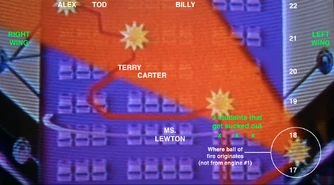
The Engines[]
In Final Destination 5, Engine #1 catches fire and eventually explodes, causing debris to puncture the fuselage and peel away. However, the engine should have never caught on fire and exploded.
In the shot to the right, a fire erupts from the outside of the plane. At first glance, one would assume that this explosion forms from one of the plane’s engines (Engine #1 or #2).
However, as mentioned above, the row where these unfortunate students were sat was at the front end of the plane’s left wing, nowhere near where either of the engines are located.
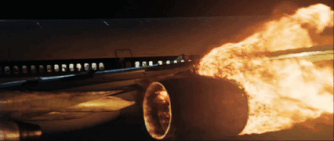
There is a fuel line connector right at the junction of where the front end of the wing and the cabin connect, and at the row in which the three ill-fated students were sat. It is based off of this evidence that the ball of fire explodes from is this particular fuel line connector. It is believed that once the third student is sucked out of the plane and the explosion occurs that this causes the ultimate downfall of Flight 180. This explosion most likely cut off fuel to Engines #1 and #2, causing the plane to nosedive and eventually explode.
To further back up the theory that it was not an exploding engine that initially took Flight 180 down, the debris from the exploding engine that sliced into the fuselage was not the cause of the three students being pulled from the airplane. There was no explosion inside the cabin in Final Destination 5 when the fuselage ripped open, compared to how the fuselage explodes and peels away in the original’s premonition.
The Explosion's Trajectory[]

The supposed trajectory of the explosion when it had occurred in real-life. Notice that it is at more of an angle than a straight wall of fire compared to the gif below.
Expanding on this part of the accident, during the news report as it shows the simulation of the explosion, at the point in which the news anchor says ‘catastrophic explosion,’ the simulation shows a spray of red, representing the explosion that kills everyone on board. As noted above, the theory that the plane exploded much earlier than in the premonition probably also resulted in a different manner that the explosion occurred.

The wall of fire from the explosion in the premonition.
The news report’s simulation shows the explosion blowing at an angle into the cabin (and ultimately killing our group of students who get kicked off—as well as everyone else), different compared to how it had occurred in the premonition when it was a wall of fire coming in straight from the front of the plane where the explosion occurred.
If observed very closely at when the plane explodes in real-life from afar (where the students are fighting in the terminal gate), the explosion originates on the left side, front end of the plane, while the trajectory of the explosion is through the cabin and out the right side of the plane, which creates the noticeable silhouette of the plane (showing that the fire did not travel through the cabin, but instead erupted across it).
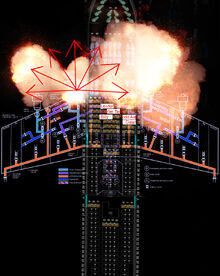
The explosion in the premonition has a trajectory angled outward and away from the passengers. Evidence in the film shows that there is no explosion angled toward the passengers in the premonition, and an explosion blowing away from them would cause a wall of fire as seen in the film.
The two images on the right is a more detailed look at the explosion's trajectory, using a Boeing 747 seating chart overlaid onto a fuel line map of a Boeing 747. Based on the news report in the film, a main pump had blown up, creating the catastrophic explosion. This main pump is located at just the front of the left wing, where Engine #3 is located. When the pump explodes both in the premonition and in real-time, the trajectory of the explosion differs in both scenes.

The explosion's trajectory is angled outward and away from the passengers as they are thrown backward into their seats. If the explosion's trajectory were angled as it were in real-time, its direction would come through the hole of the exposed fuselage and toward the passengers (allowing for a quicker death!)

Notice the difference between this diagram, and the similar diagram above. The explosion is angled more through and behind the cabin, and the explosion blows outward on the right side of the plane. In the .gif further above, with the explosion of Flight 180 from the airport's perspective, the fireball appearing on the right side of the plane (i.e. behind the plane from the airport's perspective) creates the silhouette, showing that the explosion traveled through and across the cabin, rather than outward and away from it. The explosion on the left side is also much smaller than it is in the premonition diagram above, as the explosion blew to the right and behind, instead of outward in a forward direction.
In the premonition, the direction of the explosion blows outward and away from the passengers. Evidence is shown when the explosion occurs as it tosses the passengers back into their seats, and the explosion moves toward them as a wall of fire, instead of with a trajectory angled at them, such as what the news report had shown.
In real time, as you recall reading above, when the plane initially explodes from afar, there is a noticeable silhouette of the plane as the explosion fireballs across the cabin and behind the airplane. Evidence in the film during the news report also shows, in the simulation, that the explosion had an angled trajectory at the passengers instead of away from them. This was not seen in the premonition, or the initial moment of the explosion would have looked different in the premonition, and instead of a wall of fire, it would have been a quick explosion blowing into the cabin.
Whose Leg is That?[]

When Flight 180 finally explodes and kills everyone on-board, there is a shot showing the dismemberment of the unfortunate passengers caught in the fateful eruption of fire that the plane was bound to experience. But all we really see is a leg, and for those who are curious—whose leg is that?
At the beginning of the premonition, once the plane departs from the gate, we see the flight attendants getting ready for take-off. In one shot, we notice that it shows the left side of the plane, and one female flight attendant pulling her seat down getting ready for take-off. Let’s call her Flight Attendant A.
This flight attendant is sitting in the direct line of the explosion in the premonition (reference the section above discussing the trajectory of the explosion), and since the explosion's trajectory is outward and away from the passengers, her body parts could easily be blow across the cabin and into the overhead space, as seen in the gif above.
However, two other flight attendants are sitting on the right side of the plane, one of whom becomes more noticeable moments later in the film as being an attendant who helps kick Alex off the plane after his vision. Let’s call the male one Flight Attendant B, and the female one Flight Attendant C.
Gathering from surrounding clues while watching the scene, one can only assume that they are sitting directly in line with Larry Murnau on the right side of the plane, at the front of the section that the students are in, and right at the point where the blood splatter occurs.
The last guess of whose leg that could be would be someone from First Class, as the force of the explosion blows everything back into the economy cabin. It could even be more than one person being turned inside out from the force of the explosion, which would be good reason for the large amounts of blood to splatter from the front of the plane.
The Explosion[]

Notice in the two clips how the explosion rips through the section that the students are sitting in at just about the same time. With the ‘filler clips’ removed, it shows a more accurate portrayal of how the explosion is orchestrated inside of the plane compared to outside of the plane.
The explosion of Flight 180 in Final Destination 5 was following the same manner as orchestrated in the premonition of the original, where the plane explodes further up front rather than at the left wing.
In the original film when the plane explodes, there are two ‘filler clips’ to give the movie a more dramatic impact for the scene. In this case, the shots of the blood splattering along the ceiling of the airplane cabin, as well as Alex and the other students being thrown backward into this seat, could be taken out to help with continuity purposes. In the gif to the side, you will notice that the two shots in the premonition scene are nearly seamless despite an angle change and the continuity being a second off. The filler shots were taken out to show a real-time representation of the explosion during the premonition, and actually showing a better example of where the students are sat on the plane. Remember, they’re sitting in the middle of the plane where the wings are located, so the explosion literally engulfs them immediately once you take the filler clips out.
Effects[]
The plan behind the scenes was to create an intriguing visual signature. To serve the subtleties of the script and to help personify death, production designer John Willet developed the concept of "skewing" the sets.
"What I've tried to do with the sets themselves, with their design and with various color choices, is to make things just a little unnatural," Willet explained. "Nothing that calls attention to itself, but instead creates a sense of uneasiness—the unsettling feeling that something's not quite right". To achieve this mystique, Willet designed two versions of virtually every set—one version was used before the crash and the other sets were used for scenes after the jet explodes.

Flight 180 miniature on the set.
The plane scene during which passengers die in mid-air was created inside a very large sound stage. The three-ton hydraulic gimbal was operated automatically. "We spent two months building this central set piece that weighs about 45,000 pounds and holds 89 people," special effects supervisor Terry Sonderhoff explained.
Used for filming the on-board sequences, it could be shifted on the gimbal to create a pitching movement of up to 45 degrees side-to-side and 60 degrees front-to-back, realistically conveying the horror of airborne engine failure. Sawa said that "the screams of the cast inside the gimbal made it appear more real". James Wong said, "You walk into the studio and there's a huge gimbal with a plane on top and you think, 'What have I done?' I was afraid we were gonna have 40 extras vomiting."
A miniature model of the Boeing 747 airplane was created for the explosion scene. The model, one of the most detailed miniature scenes in the film, was about 10 feet long and 7 feet wide, and the landing gear was made from all machined metals. According to visual effects supervisor Ariel Velasco Shaw, the miniature had to be launched about 40 feet up into the air to make it look like a real Boeing 747 exploded into a fireball.
To film the explosion in detail, the crew used three cameras running 120 frames per second and one camera running 300 frames per second (if they had filmed using a real-time camera, the succession of the explosion would not be filmed in a particular order).
Factual Background: Volée Flight 180 vs TWA Flight 800[]
Flight 180 has been confirmed to be very loosely based on the real-life disaster of TWA Flight 800 that occurred in 1996 near East Moriches, New York en route to Rome, with a stopover in Paris, with high school students and had also experienced an in-flight explosion due to a spark igniting the CWT (Center Wing Tank). Critic Roger Ebert, who praised the movie, called this allusion "a bit tasteless". Jeffrey Reddick has since debunked this.
The aircraft was a 25 year old Boeing 747-131, built in 1971, initially ordered by Eastern Airlines ,but purchased by TWA brand new and registered as N93119 after Eastern cancelled its orders for the 747.
A/N: (Trans-World Airlines is identified as Boeing Customer 31, and the aircraft is a -100 series, thus "-131)
It is also loosely based on the crash of Pan Am Flight 103, a Boeing 747-121 (Clipper Maid Of The Seas) in December 1988 over Lockerbie, Scotland. Many of the passengers were thrown out of the plane and fell to their deaths. Several people on the ground were also killed due to parts of the aircraft crashing to the ground.
United Airlines Flight 811, a Boeing 747-122 also experienced an accident similar to this, however the aircraft did not explode and landed safely, with a gaping hole in the right side of fuselage section 42, which was caused when the forward cargo door blew off. The door swung out with such force that it passed its normal stop and slammed into the side of the fuselage, bursting the fuselage open. Pressure differentials and aerodynamic forces caused the cabin floor to cave in, and ten seats (G and H of rows 8 through 12) were ejected from the cabin. All eight passengers seated in these locations were killed (seats 8G and 12G were unoccupied), as was the passenger in seat 9F.
Other[]
Since 2000, it was thought that the explosion of Volée Airlines Flight 180 from the original Final Destination film was one of the most tragic events in the Final Destination series, killing everyone on board. With new investigation from the prequel in 2011 revealed that Flight 180 was a result of a conspiracy and that Alex Browning was a scapegoat. With the new theory that the bridge collapse was considered the earliest event, could it be that Flight 180 was truly only Death's twisted way of cleaning up his last mess? Would it still have happened that Sam Lawton and Molly Harper had died two weeks earlier?
No. Flight 180 was meant to happen no matter if Sam and Molly had died two weeks earlier this was even shown in FD5 where Roy Carson was meant to die of an aneurysm .. while its convincing to tell that F180 was because Sam.. Alex and crew was meant to die in that flight... triggering the events in FD1... Alex also was not really at the "wrong place at the wrong time" like Molly was since he got a vision... plus death already cleaned most of the survivors of the bridge collapse at FD1 i know FD5 was a new add on but The reason that this accident nor Sam and the other survivors are ever mentioned again during the franchise is because all the people who knew about Death's List - namely Sam, Molly, Nathan Sears, Peter Friedkin, Dennis Lapman, Olivia Castle, Isaac Palmer, and Candice Hooper - had died. Everyone else, who wasn't associated with the list or investigating it, had believed this disaster to be a normal disaster; the only person who remained and knew about Death, was Bludworth. In the original Final Destination film, Flight 180 is the most known story that was brought to the public about premonitions and Death's list. Same with all the later disasters as the survivors had told other people about what was going on, and they lived to tell the tale.




